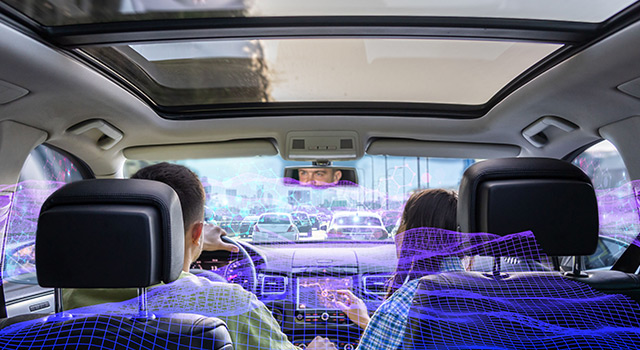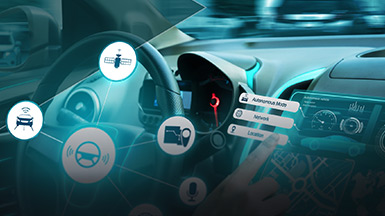

SIGNALS+ 在线快讯订阅
持续关注Signals+,了解有关连接、数字健康、电气化和智能工业的最新见解、信息和想法并加以利用。
智能神经系统驱动富有弹性的软件定义汽车
消费者希望生活中的一切,从手机、家庭娱乐到汽车,都能提供高度个性化的体验。这样的体验和功能离不开软件定义技术的支持。如今,汽车行正借助软件的力量,打造更具沉浸感、更安全、更高效的座舱体验。这些技术从根本上重新定义了价值的创造和交付方式,战略合作关系已成为成功的关键。
从引人入胜的音频和语音激活的信息娱乐系统,到高级驾驶辅助系统(ADAS),汽车行业面临的挑战在于:如何以有限的成本迅速满足消费者的期望。精明的OEM意识到,现代汽车的设计本质上是一个复杂的电气工程难题,其核心在于如何巧妙地运用先进的半导体解决方案。
半导体技术提供商需要从系统层面出发,实现一种能够支持边缘智能、稳健连接、高效电源管理、软件集中化和无线(OTA)功能更新的电气电子(E/E)架构。
新时代的曙光:软件定义汽车

“软件定义汽车或许将是我们大多数人所拥有的技术最先进的设备。这一大趋势正将我们带入一个新时代,汽车生态系统不断扩大,新参与者以前所未有的方式通力合作,以满足消费者日益多元化的需求,创造更美好的出行体验。”Yasmine King
汽车座舱体验部副总裁 | ADI公司
通过共性创造独特性

软件定义汽车(SDV)技术正在改变我们的驾乘体验。它可以根据乘客的需求自动调整车内环境,营造个性化的舒适空间。此外,它还能增强出行安全,优化车辆性能。这些创新使汽车制造商能够提供独特的、不断进化的体验(通过OTA更新),培养消费者对品牌的忠诚度和信任,并提升他们整体的用车感受。借助精准技术手段,汽车制造商可以深入了解消费者偏好,从而帮助推动战略创新,并加强与购车者的长期关系。
挑战在于找到最佳策略,以在满足消费者期望的同时加速部署。一个答案是让OEM能够利用标准化、可扩展的半导体平台,这将有助于加快开发速度、控制成本并保持品牌差异化。汽车制造商可以利用这些可扩展平台来更好地重用软件代码并确保竞争优势。
“我们需要让汽车的硬件架构像智能手机一样通用且可编程。主要目标是让汽车制造商能够打造出差异化产品。灵活的连接让任何数据都能被任意功能所调用。在功能安全、信息安全和法规的约束下,这种连接能力赋予开发应用程序的软件开发人员以最大自由度。”Geir Ostrem
汽车座舱体验部技术研究员 | ADI公司
实现汽车智能神经系统
到2030年,软件定义汽车预计将产生大约200 Gbps的数据,其中主要是视频1。为了在车辆边缘的传感器之间传输这些数据,以及将其传输到高性能车辆计算机、存储器、显示器和执行器,需要高速有线数据链路。这些高速链路与强大的计算能力和AI相结合,让汽车制造商能够提升消费者在驾驶和用车过程中的体验。
边缘处理允许传感器在本地做出实时决策,而无需依赖集中式云计算系统,这将有助于降低处理需求。通过这种智能边缘,汽车制造商可以利用精准的实时智能增强消费者的驾驶和用车体验。
为了简化SDV架构,实现智能边缘,提升平台价值,以及提高能效,系统级设计对于半导体公司来说很有必要。ADI公司的智能神经系统模仿人类的神经系统,通过连接各种子系统实现无缝互操作性和实时适应性,而不会增加复杂性。该系统支持SDV快速收集和分析数据,从而做出快速明智的决策,优化性能和安全性,并适应不断变化的条件。
随着汽车行业将原本分散的域控制器和特定功能控制器整合为中央跨域计算单元,软件将实现集中化管理,以便支持频繁的无线更新,从而降低车辆保修成本并改善用户体验。跨域分区控制器的应用大幅减少了车内布线,但要实现数据流通畅和各子系统的无缝控制,还需依赖更先进的网络技术。这一变化要求我们重新审视车辆内部软件和硬件的设计、集成与管理方式。
汽车智能神经系统的三项能力

配置
配置意味着确保系统之间无缝通信,以实现高效运作和及时决策。以高级驾驶辅助系统(ADAS)为例。在有雾的情况下,传感器检测到物体,算法分析数据,车辆发出警告,同时准备刹车或避开物体。从摄像头到决策算法,再到执行响应的机制,每个组件都必须协同工作以确保安全和性能。
综合
综合侧重于车辆聚合、融合和处理来自多个传感器的数据的能力。它代表了车辆的智能边缘,车辆基于全面的数据分析快速作出决策,就像人的本能反应一样。设想一辆汽车在繁忙的城市环境中行驶。这辆汽车需要整合车载传感器(如摄像头、激光雷达和雷达)的数据以及GPS和V2X输入,以增强态势感知和决策能力。综合还涉及理解人类交互,例如语音命令,以提高车辆智能和响应能力,使得车辆不再只是被动等待指令,而是能够主动预测并应对各种情况。
协调
最后一步是协调,这是将SDV的智能神经系统各部分紧密结合在一起的关键。通过协调各种硬件平台,车辆可以具备洞察能力,支持扩展,促进生态系统整合。协调还能确保所有硬件和软件元素和谐地一起工作,让车辆在各种条件下高效安全地运行。
优化数字驾驶舱的智能边缘
确立了“配置”、“综合”和“协调”这三项能力之后,我们需要优化智能边缘,以实现我们对汽车技术变革的愿景。当今的车辆依赖三个主要网络——音频、视觉和车身控制,这些网络构成了车辆的基础。此外,我们还需要简化电缆和接线,优化生产流程,提升可靠性和维护便利性。



在音频网络中,我们开发了通过低成本电线实时传输音频信号的能力。在车身控制中,我们消除了微控制器和边缘软件,降低了成本并简化了架构,使软件定义特性更易于使用。这种方法还加强了网络安全,保障了车内乘客的隐私和安全。
针对视觉和感知网络,为了应对来自摄像头、雷达和激光雷达的海量数据,同时简化线束,更高带宽的解决方案变得至关重要。
ADI公司通过其先进的技术解决方案组合来实现这些能力。

“到2030年,随着路噪降噪、空间音频、语音控制等高级音频和声学应用的发展,音频处理需求预计会增长2.5倍,扬声器和麦克风的数量预计会增长2倍。同样,车身电子设备的数量预计将增加45%。为了实现低延迟连接,并降低相关的硬件复杂性、功耗和成本,必须将ECU合并到中央计算平台中,并与基于10BASE-T1S以太网的分区控制器联网。”Andrew Lanfear
营销经理 – 处理器和DSP
法规在推动SDV转型中发挥重要作用政府法规在加速SDV转型方面也发挥着重要作用,包括在全球范围内强制实施严格的安全标准,这需要边缘具备智能处理能力。这些安全要求对车辆功能提出了更高的要求,而通过软件定义(SD)技术来达到这些要求将是最佳选择。此类法规包括:
|
“当前的3级ADAS配备了12个以上的摄像头和多个雷达,如今的高端汽车可能配备了4块以上的显示屏。这一趋势只会不断增强,以实现更复杂的安全功能、自动驾驶和信息娱乐系统。在这个汽车行业日新月异的时代,确保视频和感知传感器数据连接稳定可靠,同时尽量减少布线和软件开销,已成为一项关键任务。”Bala Mayampurath
汽车视频和数据解决方案部副总裁 | ADI公司
SDV的核心价值:愉悦的用车体验

要重新定义未来的移动出行,我们必须培育一个和谐的生态系统。在这个生态系统中,我们希望通过个性化定制、提升车辆价值和激发生态效应,让更多人能够享受拥有汽车的乐趣。
我们参与的生态系统远不止于各个部分的简单组合,它是一个充满活力的平台,让我们能够深入了解消费者行为,从而帮助我们与客户建立长期关系,并通过调整和演进来满足他们不断变化的需求。生态系统中的合作伙伴可以共创共建,利用标准化的半导体平台、车辆的神经系统以及它所带来的敏捷性,更快地将新的特性和能力推向市场,并推动可持续发展。
参考文献
1ADI公司内部估算
2NIH;采用基于面部特征的眼睑闭合检测和头部姿态识别技术的实时驾驶员监控系统
3 联合国条约库
42021年热车法案
5汽车创新联盟;FCC批准重要安全技术:当儿童被遗忘在高温车内时,向驾驶员发出警报




 关闭详情
关闭详情


